-
-
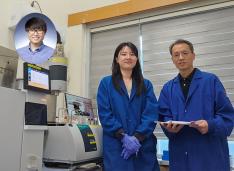 research KAIST Uses AI to Discover Optimal New Material for Removing Radioactive Iodine Contamination
research KAIST Uses AI to Discover Optimal New Material for Removing Radioactive Iodine ContaminationManaging radioactive waste is one of the core challenges in the use of nuclear energy. In particular, radioactive iodine poses serious environmental and health risks due to its long half-life (15.7 million years in the case of I-129), high mobility, and toxicity to living organisms. A Korean research team has successfully used artificial intelligence to discover a new material that can remove io...
-
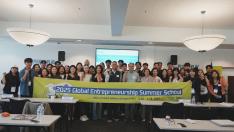 event 2025 KAIST Global Entrepreneurship Summer School Concludes Successfully in Silicon Valley
event 2025 KAIST Global Entrepreneurship Summer School Concludes Successfully in Silicon ValleyThe “2025 KAIST Global Entrepreneurship Summer School (2025 KAIST GESS),” organized by the Office of Global Initiative of the KAIST International Office (Vice President So Young Kim), successfully concluded. Now in its fourth year, the program was designed to provide KAIST students with firsthand experience of the world’s leading startup ecosystem in Silicon Valley, USA, and to strengthen ...
-
-
-
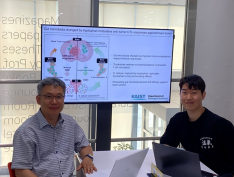 research KAIST Enhances Immunotherapy for Difficult-to-Treat Brain Tumors with Gut Microbiota
research KAIST Enhances Immunotherapy for Difficult-to-Treat Brain Tumors with Gut MicrobiotaAdvanced treatments, known as immunotherapies that activate T cells—our body's immune cells—to eliminate cancer cells, have shown limited efficacy as standalone therapies for glioblastoma, the most lethal form of brain tumor. This is due to their minimal response to glioblastoma and high resistance to treatment.
-
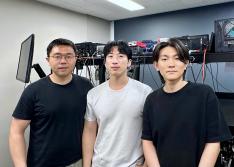 research High-Resolution Spectrometer that Fits into Smartphones Developed by KAIST Researchers
research High-Resolution Spectrometer that Fits into Smartphones Developed by KAIST ResearchersColor, as the way light\`s wavelength is perceived by the human eye, goes beyond a simple aesthetic element, containing important scientific information like a substance\`s composition or state. Spectrometers are optical devices that analyze material properties by decomposing light into its constituent wavelengths, and they are widely used in various scientific and industrial fields, including m...
-
-
-
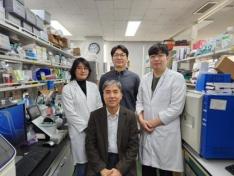 research KAIST Identifies Master Regulator Blocking Immunotherapy, Paving the Way for a New Lung Cancer Treatment
research KAIST Identifies Master Regulator Blocking Immunotherapy, Paving the Way for a New Lung Cancer TreatmentKAIST researchers have discovered that \`DEAD-box helicases 54 (DDX54)\`, a type of RNA-binding protein, is the master regulator that hinders the effectiveness of immunotherapy—opening a new path for lung cancer treatment.
-
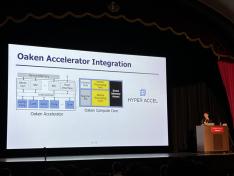 research Development of Core NPU Technology to Improve ChatGPT Inference Performance by Over 60%
research Development of Core NPU Technology to Improve ChatGPT Inference Performance by Over 60%Latest generative AI models such as OpenAI's ChatGPT-4 and Google's Gemini 2.5 require not only high memory bandwidth but also large memory capacity. This is why generative AI cloud operating companies like Microsoft and Google purchase hundreds of thousands of NVIDIA GPUs. As a solution to address the core challenges of building such high-performance AI infrastructure, Korean ...
-
-
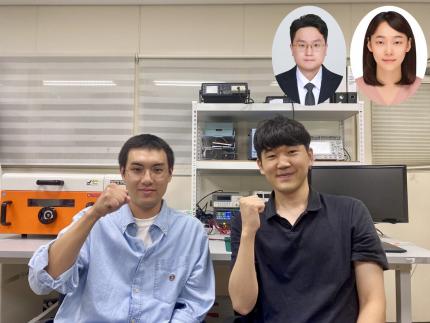 research Is 24-hour health monitoring possible with ambient light energy?
research Is 24-hour health monitoring possible with ambient light energy?<(From left) Ph.D candidate Youngmin Sim, Ph.D candidate Do Yun Park, Dr. Chanho Park, Professor Kyeongha Kwon> Miniaturization and weight reduction of medical wearable devices for continuous health monitoring such as heart rate, blood oxygen saturation, and sweat component analysis remain major challenges. In particular, optical sensors consume a significant amount of power for LED operation and wireless transmission, requiring heavy and bulky batteries. To overcome these limitations, KAIST researchers have developed a next-generation wearable platform that enables 24-hour continuous measurement by using ambient light as an energy source and optimizing power management according to the power environment. KAIST (President Kwang Hyung Lee) announced on the 30th that Professor Kyeongha Kwon's team from the School of Electrical Engineering, in collaboration with Dr. Chanho Park’s team at Northwestern University in the U.S., has developed an adaptive wireless wearable platform that reduces battery load by utilizing ambient light. To address the battery issue of medical wearable devices, Professor Kyeongha Kwon’s research team developed an innovative platform that utilizes ambient natural light as an energy source. This platform integrates three complementary light energy technologies. <Figure1.The wireless wearable platform minimizes the energy required for light sources through i) Photometric system that directly utilizes ambient light passing through windows for measurements, ii) Photovoltaic system that receives power from high-efficiency photovoltaic cells and wireless power receiver coils, and iii) Photoluminescent system that stores light using photoluminescent materials and emits light in dark conditions to support the two aforementioned systems. In-sensor computing minimizes power consumption by wirelessly transmitting only essential data. The adaptive power management system efficiently manages power by automatically selecting the optimal mode among 11 different power modes through a power selector based on the power supply level from the photovoltaic system and battery charge status.>
-
 research KAIST Enables On-Site Disease Diagnosis in Just 3 Minutes... Nanozyme Reaction Selectivity Improved 38-Fold
research KAIST Enables On-Site Disease Diagnosis in Just 3 Minutes... Nanozyme Reaction Selectivity Improved 38-Fold<(From Left) Professor Jinwoo Lee, Ph.D candidate Seonhye Park and Ph.D candidate Daeeun Choi from Chemical & Biomolecular Engineering> To enable early diagnosis of acute illnesses and effective management of chronic conditions, point-of-care testing (POCT) technology—diagnostics conducted near the patient—is drawing global attention. The key to POCT lies in enzymes that recognize and react precisely with specific substances. However, traditional natural enzymes are expensive and unstable, and nanozymes (enzyme-mimicking catalysts) have suffered from low reaction selectivity. Now, a Korean research team has developed a high-sensitivity sensor platform that achieves 38 times higher selectivity than existing nanozymes and allows disease diagnostics visible to the naked eye within just 3 minutes. On the 28th, KAIST (President Kwang Hyung Lee) announced that Professor Jinwoo Lee’s research team from the Department of Chemical & Biomolecular Engineering, in collaboration with teams led by Professor Jeong Woo Han at Seoul National University and Professor Moon Il Kim at Gachon University, has developed a new single-atom catalyst that selectively performs only peroxidase-like reactions while maintaining high reaction efficiency. Using bodily fluids such as blood, urine, or saliva, this diagnostic platform enables test results to be read within minutes even outside hospital settings—greatly improving medical accessibility and ensuring timely treatment. The key lies in the visual detection of biomarkers (disease indicators) through color changes triggered by enzyme reactions. However, natural enzymes are expensive and easily degraded in diagnostic environments, limiting their storage and distribution. To address this, inorganic nanozyme materials have been developed as substitutes. Yet, they typically lack selectivity—when hydrogen peroxide is used as a substrate, the same catalyst triggers both peroxidase-like reactions (which cause color change) and catalase-like reactions (which remove the substrate), reducing diagnostic signal accuracy. To control catalyst selectivity at the atomic level, the researchers used an innovative structural design: attaching chlorine (Cl) ligands in a three-dimensional configuration to the central ruthenium (Ru) atom to fine-tune its chemical properties. This enabled them to isolate only the desired diagnostic signal. <Figure1. The catalyst in this study (ruthenium single-atom catalyst) exhibits peroxidase-like activity with selectivity akin to natural enzymes through three-dimensional directional ligand coordination. Due to the absence of competing catalase activity, selective peroxidase-like reactions proceed under biomimetic conditions. In contrast, conventional single-atom catalysts with active sites arranged on planar surfaces exhibit dual functionality depending on pH. Under neutral conditions, their catalase activity leads to hydrogen peroxide depletion, hindering accurate detection. The catalyst in this study eliminates such interference, enabling direct detection of biomarkers through coupled reactions with oxidases without the need for cumbersome steps like buffer replacement. The ability to simultaneously detect multiple target substances under biomimetic conditions demonstrates the practicality of ruthenium single-atom catalysts for on-site diagnostics> Experimental results showed that the new catalyst achieved over 38-fold improvement in selectivity compared to existing nanozymes, with significantly increased sensitivity and speed in detecting hydrogen peroxide. Even in near-physiological conditions (pH 6.0), the catalyst maintained its performance, proving its applicability in real-world diagnostics. By incorporating the catalyst and oxidase into a paper-based sensor, the team created a system that could simultaneously detect four key biomarkers related to health: glucose, lactate, cholesterol, and choline—all with a simple color change. This platform is broadly applicable across various disease diagnostics and can deliver results within 3 minutes without complex instruments or pH adjustments. The findings show that diagnostic performance can be dramatically improved without changing the platform itself, but rather by engineering the catalyst structure. <Figure 2.(a) Schematic diagram of the paper sensor (Zone 1: glucose oxidase immobilized; Zone 2: lactate oxidase immobilized; Zone 3: choline oxidase immobilized; Zone 4: cholesterol oxidase immobilized; Zone 5: no oxidase enzyme). (b) Single biomarker (single disease indicator) detection using the ruthenium single‑atom catalyst–based paper sensor.(c) Multiple biomarker (multiple disease indicator) detection using the ruthenium single‑atom catalyst–based paper sensor> Professor Jinwoo Lee of KAIST commented, “This study is significant in that it simultaneously achieves enzyme-level selectivity and reactivity by structurally designing single-atom catalysts.” He added that “the structure–function-based catalyst design strategy can be extended to the development of various metal-based catalysts and other reaction domains where selectivity is critical.” Seonhye Park and Daeeun Choi, both Ph.D. candidates at KAIST, are co-first authors. The research was published on July 6, 2025, in the prestigious journal Advanced Materials. ● Title: Breaking the Selectivity Barrier of Single-Atom Nanozymes Through Out-of-Plane Ligand Coordination ● Authors: Seonhye Park (KAIST, co–first author), Daeeun Choi (KAIST, co–first author), Kyu In Shim (SNU, co–first author), Phuong Thy Nguyen (Gachon Univ., co–first author), Seongbeen Kim (KAIST), Seung Yeop Yi (KAIST), Moon Il Kim (Gachon Univ., corresponding author), Jeong Woo Han (SNU, corresponding author), Jinwoo Lee (KAIST, corresponding author) ● DOI: https://doi.org/10.1002/adma.202506480 This research was supported by the Ministry of Science and ICT and the National Research Foundation of Korea (NRF).
-
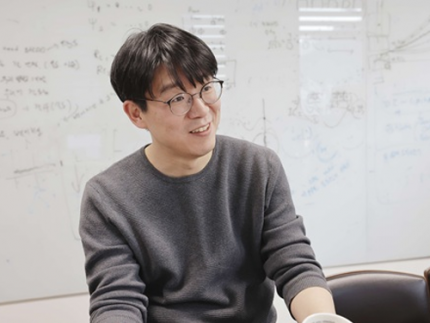 research Better Sleep, Better Life — KAIST’s Sleep Algorithm Comes to Samsung Galaxy Watches
research Better Sleep, Better Life — KAIST’s Sleep Algorithm Comes to Samsung Galaxy Watches<Professor Jae Kyoung Kim of KAIST's Department of Mathematical Sciences> Did you know that over 80% of people worldwide have irregular sleep habits? These sleep issues don’t just leave us feeling tired — they affect our health, focus, and quality of life. Now, a new sleep algorithm developed by a team of Korean researchers is aiming to change that. And it’s available on Samsung Galaxy smartwatches around the world, including the newly launched Galaxy Watch8 series. The personalized sleep guide, created by Professor Jae Kyoung Kim’s research team at KAIST and the Institute for Basic Science (IBS), doesn’t just tell you how long you slept. It actually recommends the best time for you to go to bed — helping you build healthy sleep habits and feel more refreshed every day. What makes it special? Unlike most sleep features that focus only on the past (“You slept six hours last night”), this algorithm looks ahead. Using mathematical models and your body’s circadian rhythm, it suggests a personalized “sleep window” — like “Going to bed between 11:10 PM and 11:40 PM is ideal for you tonight.” “It’s kind of like a weather forecast,” said Professor Kim. “Instead of just telling you what happened yesterday, it helps you prepare for tomorrow — so you can sleep better and feel better.” <Conceptual Diagram of a Smart Sleep Algorithm> The algorithm was developed over three years by a small team of mathematicians, not professional app developers. “We faced a lot of challenges trying to turn our research into a real product,” Kim admitted. “People kept asking us when they could try the algorithm, and we always felt bad that we couldn’t release it properly. Now, thanks to the support of KAIST’s Technology Commercialization Center and our partnership with Samsung, our work will finally reach people around the world.” The academic world is paying attention, too. Professor Kim’s presentation on the algorithm was selected for the Hot Topics session at SLEEP 2025, the world’s largest sleep conference held in the U.S., and will also be featured at World Sleep 2025 in Singapore this fall. Professor Kim is also working with Professor Eun Yeon Joo’s team at Samsung Medical Center to develop even more advanced sleep recommendation technology. Together, they created “SLEEPS,” an algorithm that predicts sleep disorders (available at sleep-math.com). Meanwhile, development continues on their own sleep app — with the hope of bringing math-powered sleep science into more people’s everyday lives. Professor Kim is a world-renowned expert in mathematical biology. In 2025, he became the first Korean scientist to give a keynote speech at the SIAM Annual Meeting, and the first Korean to join the editorial board of SIAM Review, one of the most prestigious journals in applied mathematics. His work shows how basic science and mathematics can lead to real solutions that help people live healthier, better lives.
-
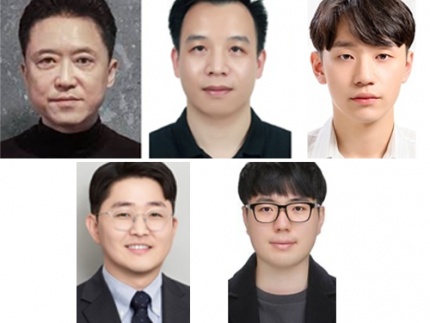 research Vulnerability Found: One Packet Can Paralyze Smartphones
research Vulnerability Found: One Packet Can Paralyze Smartphones<(From left) Professor Yongdae Kim, PhD candidate Tuan Dinh Hoang, PhD candidate Taekkyung Oh from KAIST, Professor CheolJun Park from Kyung Hee University; and Professor Insu Yun from KAIST> Smartphones must stay connected to mobile networks at all times to function properly. The core component that enables this constant connectivity is the communication modem (Baseband) inside the device. KAIST researchers, using their self-developed testing framework called 'LLFuzz (Lower Layer Fuzz),' have discovered security vulnerabilities in the lower layers of smartphone communication modems and demonstrated the necessity of standardizing 'mobile communication modem security testing.' *Standardization: In mobile communication, conformance testing, which verifies normal operation in normal situations, has been standardized. However, standards for handling abnormal packets have not yet been established, hence the need for standardized security testing. Professor Yongdae Kim's team from the School of Electrical Engineering at KAIST, in a joint research effort with Professor CheolJun Park's team from Kyung Hee University, announced on the 25th of July that they have discovered critical security vulnerabilities in the lower layers of smartphone communication modems. These vulnerabilities can incapacitate smartphone communication with just a single manipulated wireless packet (a data transmission unit in a network). In particular, these vulnerabilities are extremely severe as they can potentially lead to remote code execution (RCE) The research team utilized their self-developed 'LLFuzz' analysis framework to analyze the lower layer state transitions and error handling logic of the modem to detect security vulnerabilities. LLFuzz was able to precisely extract vulnerabilities caused by implementation errors by comparing and analyzing 3GPP* standard-based state machines with actual device responses. *3GPP: An international collaborative organization that creates global mobile communication standards. The research team conducted experiments on 15 commercial smartphones from global manufacturers, including Apple, Samsung Electronics, Google, and Xiaomi, and discovered a total of 11 vulnerabilities. Among these, seven were assigned official CVE (Common Vulnerabilities and Exposures) numbers, and manufacturers applied security patches for these vulnerabilities. However, the remaining four have not yet been publicly disclosed. While previous security research primarily focused on higher layers of mobile communication, such as NAS (Network Access Stratum) and RRC (Radio Resource Control), the research team concentrated on analyzing the error handling logic of mobile communication's lower layers, which manufacturers have often neglected. These vulnerabilities occurred in the lower layers of the communication modem (RLC, MAC, PDCP, PHY*), and due to their structural characteristics where encryption or authentication is not applied, operational errors could be induced simply by injecting external signals. *RLC, MAC, PDCP, PHY: Lower layers of LTE/5G communication, responsible for wireless resource allocation, error control, encryption, and physical layer transmission. The research team released a demo video showing that when they injected a manipulated wireless packet (malformed MAC packet) into commercial smartphones via a Software-Defined Radio (SDR) device using packets generated on an experimental laptop, the smartphone's communication modem (Baseband) immediately crashed ※ Experiment video: https://drive.google.com/file/d/1NOwZdu_Hf4ScG7LkwgEkHLa_nSV4FPb_/view?usp=drive_link The video shows data being normally transmitted at 23MB per second on the fast.com page, but immediately after the manipulated packet is injected, the transmission stops and the mobile communication signal disappears. This intuitively demonstrates that a single wireless packet can cripple a commercial device's communication modem. The vulnerabilities were found in the 'modem chip,' a core component of smartphones responsible for calls, texts, and data communication, making it a very important component. Qualcomm: Affects over 90 chipsets, including CVE-2025-21477, CVE-2024-23385. MediaTek: Affects over 80 chipsets, including CVE-2024-20076, CVE-2024-20077, CVE-2025-20659. Samsung: CVE-2025-26780 (targets the latest chipsets like Exynos 2400, 5400). Apple: CVE-2024-27870 (shares the same vulnerability as Qualcomm CVE). The problematic modem chips (communication components) are not only in premium smartphones but also in low-end smartphones, tablets, smartwatches, and IoT devices, leading to the widespread potential for user harm due to their broad diffusion. Furthermore, the research team experimentally tested 5G vulnerabilities in the lower layers and found two vulnerabilities in just two weeks. Considering that 5G vulnerability checks have not been generally conducted, it is possible that many more vulnerabilities exist in the mobile communication lower layers of baseband chips. Professor Yongdae Kim explained, "The lower layers of smartphone communication modems are not subject to encryption or authentication, creating a structural risk where devices can accept arbitrary signals from external sources." He added, "This research demonstrates the necessity of standardizing mobile communication modem security testing for smartphones and other IoT devices." The research team is continuing additional analysis of the 5G lower layers using LLFuzz and is also developing tools for testing LTE and 5G upper layers. They are also pursuing collaborations for future tool disclosure. The team's stance is that "as technological complexity increases, systemic security inspection systems must evolve in parallel." First author Tuan Dinh Hoang, a Ph.D. student in the School of Electrical Engineering, will present the research results in August at USENIX Security 2025, one of the world's most prestigious conferences in cybersecurity. ※ Paper Title: LLFuzz: An Over-the-Air Dynamic Testing Framework for Cellular Baseband Lower Layers (Tuan Dinh Hoang and Taekkyung Oh, KAIST; CheolJun Park, Kyung Hee Univ.; Insu Yun and Yongdae Kim, KAIST) ※ Usenix paper site: https://www.usenix.org/conference/usenixsecurity25/presentation/hoang (Not yet public), Lab homepage paper: https://syssec.kaist.ac.kr/pub/2025/LLFuzz_Tuan.pdf ※ Open-source repository: https://github.com/SysSec-KAIST/LLFuzz (To be released) This research was conducted with support from the Institute of Information & Communications Technology Planning & Evaluation (IITP) funded by the Ministry of Science and ICT.
-
 research Immune Signals Directly Modulate Brain's Emotional Circuits: Unraveling the Mechanism Behind Anxiety-Inducing Behaviors
research Immune Signals Directly Modulate Brain's Emotional Circuits: Unraveling the Mechanism Behind Anxiety-Inducing BehaviorsKAIST's Department of Brain and Cognitive Sciences, led by Professor Jeong-Tae Kwon, has collaborated with MIT and Harvard Medical School to make a groundbreaking discovery. For the first time globally, their joint research has revealed that cytokines, released during immune responses, directly influence the brain's emotional circuits to regulate anxiety behavior. The study provided experimental evidence for a bidirectional regulatory mechanism: inflammatory cytokines IL-17A and IL-17C act on specific neurons in the amygdala, a region known for emotional regulation, increasing their excitability and consequently inducing anxiety. Conversely, the anti-inflammatory cytokine IL-10 was found to suppress excitability in these very same neurons, thereby contributing to anxiety alleviation. In a mouse model, the research team observed that while skin inflammation was mitigated by immunotherapy (IL-17RA antibody), anxiety levels paradoxically rose. This was attributed to elevated circulating IL-17 family cytokines leading to the overactivation of amygdala neurons. Key finding: Inflammatory cytokines IL-17A/17C promote anxiety by acting on excitable amygdala neurons (via IL-17RA/RE receptors), whereas anti-inflammatory cytokine IL-10 alleviates anxiety by suppressing excitability through IL-10RA receptors on the same neurons. The researchers further elucidated that the anti-inflammatory cytokine IL-10 works to reduce the excitability of these amygdala neurons, thereby mitigating anxiety responses. This research marks the first instance of demonstrating that immune responses, such as infections or inflammation, directly impact emotional regulation at the level of brain circuits, extending beyond simple physical reactions. This is a profoundly significant achievement, as it proposes a crucial biological mechanism that interlinks immunity, emotion, and behavior through identical neurons within the brain. The findings of this research were published in the esteemed international journal Cell on April 17th of this year. Paper Information: Title: Inflammatory and anti-inflammatory cytokines bidirectionally modulate amygdala circuits regulating anxiety Journal: Cell (Vol. 188, 2190–2220), April 17, 2025 DOI: https://doi.org/10.1016/j.cell.2025.03.005 Corresponding Authors: Professor Gloria Choi (MIT), Professor Jun R. Huh (Harvard Medical School)
-
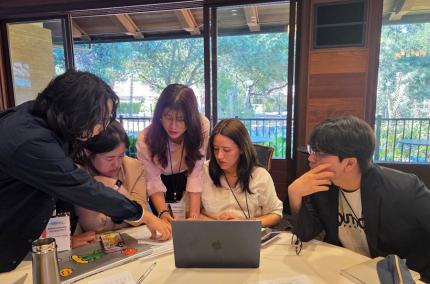 event KAIST GESS Team Awarded Honorable Mention at 2025 Entrepreneurship Olympiad
event KAIST GESS Team Awarded Honorable Mention at 2025 Entrepreneurship Olympiad<Photo: eaureco team at the final pitch> The KAIST Global Entrepreneurship Summer School (GESS) winning team, eaureco, earned an Honorable Mention at the 2025 Entrepreneurship Olympiad, held July 21–23 at Stanford Faculty Club and hosted by Techdev Academy. Competing in the college track, the team showcased their innovative solution among participants from top institutions including Stanford University, UC Berkeley, UCLA, and UC San Diego. Team eaureco—comprising KAIST undergraduate and graduate students Jiwon Park(Semiconductor Systems Engineering), Si Li Sara (Julia) Aow, Lunar Sebastian Widjaja (both Civil & Environmental Engineering), Seoyeon Jang (Impact MBA), and Isabel Alexandra Cornejo Lima (BTM/Global Digital Innovation)—presented a B2B solution that upcycles discarded seaweed into biodegradable ice packs for cold-chain companies. Their business model was recognized for its alignment with sustainability, resource circulation, and social impact goals. <Photo: eaureco team preparing for the final pitch> The team’s ability to rapidly adapt their pitch based on mentor feedback and clearly communicate the value of their idea to judges contributed to their recognition. This accomplishment further highlights the impact of KAIST's GESS program, which supports students in building real-world entrepreneurial skills through immersive learning experiences in Silicon Valley. “The GESS program helped us refine every aspect of our business idea—from identifying the problem to developing a go-to-market strategy,” said Si Li Sara (Julia) Aow, a member of the eaureco team. “We’re grateful for the opportunity to showcase our work on a global stage and hope to continue developing innovations that drive meaningful change.” “This award reaffirms the creative potential and practical capabilities of KAIST students in global innovation ecosystems,” said Dr. Soyoung Kim, Vice President of International Office. “We will continue to invest in programs like GESS to empower our students as future leaders in entrepreneurship.” The Entrepreneurship Olympiad is a global event designed to foster innovation, entrepreneurship, and collaboration among young change-makers. This year’s program featured keynote talks, panels, and workshops led by industry pioneers including Marc Tarpenning (Co-founder, Tesla Motors), Pat Brown (Founder, Impossible Foods), and other influential entrepreneurs from the biotech, fintech, and deeptech sectors. The Honorable Mention recognition underscores KAIST’s commitment to global entrepreneurship education and the growing international visibility of the GESS program.
-
 event KAIST School of Transdisciplinary Studies Is Driving Innovation in Korean Education
event KAIST School of Transdisciplinary Studies Is Driving Innovation in Korean Education<(From Left) Professor Jaeseung Jeong, haed of the School of Transdiciplinary Studies, Dr, Albert Chau, Vice President of Hong Kong Baptist University> KAIST (President Kwang Hyung Lee) announced on the 24th of July that its School of Transdisciplinary Studies has been consistently showcasing the results of its experiments and practices for educational innovation both domestically and abroad. On June 27, Professor Jaeseung Jeong, head of the School of Transdisciplinary Studies, was invited to speak at the “Pacific Asia Summit on Transdisciplinary Education 2025 (PASTE 2025)” held at Hong Kong Baptist University. He presented the Korean model of transdisciplinary education under the title “The Philosophy and Achievements of the KAIST School of Transdisciplinary Studies.” In his talk, Professor Jeong pointed out the limitations of conventional education systems that rely on answer-centered evaluation, perfectionism, and competitiveness, claiming that they hinder creativity and integrative thinking. He then introduced the philosophy and operational practices of the School of Transdisciplinary Studies, which was established in 2019 to overcome these issues. Professor Jeong outlined five key principles that define the school's educational philosophy: ①a broad and integrative academic foundation, ②student-driven and customized education, ③creativity and execution, ④a sense of social responsibility and global citizenship, and ⑤learning driven by intrinsic motivation and curiosity. He explained that students are admitted without a declared major, allowed to design their own learning plans, and evaluated under a P/NR system* that focuses on growth rather than competition. *P/NR system: A non-competitive grading system led by KAIST’s School of Transdisciplinary Studies. Instead of traditional letter grades (A/B/C/Fail), students receive Pass (P) or No Record (NR), with the latter not appearing as a failure and not affecting GPA. Professor Jeong emphasized, “This experiment at KAIST represents a new educational paradigm that values questions over knowledge, culture over structure, and inquiry over competition. Students are bridging academic learning and real-world practice by addressing societal challenges through technology, which could lead to a fundamental shift in global higher education.” His presentation provided an opportunity to spotlight how KAIST’s experimental approach to nurturing transdisciplinary talent is pointing to new directions for the global education community beyond Korea. < Hyungjoon Jang, a student at the School of Transdisciplinary Studies> The achievements of KAIST’s transdisciplinary education model are also reflected in students’ academic accomplishments. Hyungjoon Jang, a student at the School of Transdisciplinary Studies, participated in a collaborative study led by his mentor, Professor Jaekyung Kim in the Department of Mathematical Sciences, along with researchers from Chungnam National University and the Institute for Basic Science (IBS). Their groundbreaking analytical method enables the accurate estimation of inhibition constants using only a single inhibitor concentration. The paper was published in the prestigious journal Nature Communications in June, with Jang listed as co–first author. Jang played a leading role throughout the research process by developing the experimental methodology, creating a software package to support the method, drafting the manuscript, and engaging in peer review. He also effectively communicated mathematical and statistical models to pharmaceutical experts by mastering presentation techniques and visual explanation strategies, thereby setting a strong example of interdisciplinary collaboration. He emphasized that “the School of Transdisciplinary Studies’ mentor system allowed regular research feedback and the systematic acquisition of essential knowledge and analytical skills through courses in biochemistry and computational neuroscience.” This example demonstrates how undergraduate students at the School of Transdisciplinary Studies can take leading roles in cutting-edge interdisciplinary research. The school’s educational philosophy is also reflected in students’ practical actions. Inseo Jeong, a current student and founder of the startup MPAge Inc., made a meaningful donation to help establish a creative makerspace in the school. <Inseo Jeong, founder of MPAG> Inseo Jeong explained that the decision was made to express gratitude for the knowledge gained and the mentorship received from professors, saying that at the School of Transdisciplinary Studies, she learned not only how to solve problems with technology but also how to view society, and that learning has helped her grow. She added, “The deep understanding of humanity and the world emphasized by Professor Jaeseung Jeong will be a great asset not only to entrepreneurs but to all students pursuing diverse paths,” expressing support for her fellow students. Inseo Jeong collaborated for over two years with Professor Hyunwook Ka of the School of Transdisciplinary Studies on software research for individuals with hearing impairments. After numerous algorithm designs and experimental iterations, their work, which considered the social scalability of technology, was presented at the world-renowned CSUN Assistive Technology Conference held at California State University, Northridge. The project has filed for a patent under KAIST’s name. ※ Presentation title: Evidence-Based Adaptive Transcription for Sign Language Users KAIST is now working to complete the makerspace on the third floor of the Administrative Annex (N2) in Room 314 with a size of approximately 33 m2 during the summer. The makerspace is expected to serve as a hands-on, integrative learning environment where various ideas can be realized and implemented, playing a key role in fostering students’ creative problem-solving and integrative thinking skills. KAIST President Kwang Hyung Lee stated, “The School of Transdisciplinary Studies is both an experimental ground and a practical field for overcoming the limitations of traditional education and nurturing global talents with creative problem-solving skills and integrative thinking, which are essential for the future.” He added, “KAIST will continue to lead efforts to cultivate question-asking, inquiry-driven, transdisciplinary talents and propose new paradigms for education and research.”
-
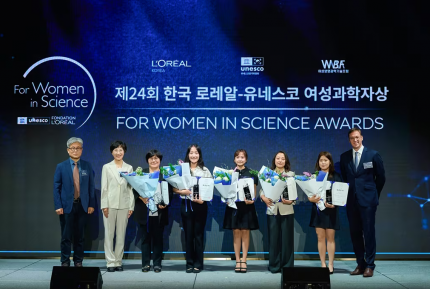 event KAIST's Lim Mi-hee wins Korea's L'Oréal-UNESCO Women in Science Award
event KAIST's Lim Mi-hee wins Korea's L'Oréal-UNESCO Women in Science AwardLim Mi-hee, a professor at the Korea Advanced Institute of Science and Technology (KAIST) Department of Chemistry, received the Academic Promotion Award at the 24th Korean L'Oréal-UNESCO Women in Science Awards ceremony. L'Oréal Korea, the Korean National Commission for UNESCO, and the Women’s Bioscience Forum held the 24th Korean L'Oréal-UNESCO Women in Science Awards ceremony on the 16th and noted that Lim Mi-hee was selected for this year’s Academic Promotion Award. Professor Lim was recognized for her research on the causes of Alzheimer's disease at the molecular level and her efforts in the discovery of intracellular proteins that promote the toxicity of Alzheimer’s-inducing factors. Professor Lim is a full member of the Korean Academy of Science and Technology (KAST) and has received several awards including the Hanseong Science Award, this year's Women in Science and Technology Award, and the RIGAKU-ACCC Award (Asia's top woman scientist). The fellowship section, awarded to four emerging women scientists, includes Kang Mi-kyung, an assistant professor at Korea University’s Department of Health and Environmental Sciences; Jeon Ji-hye, an assistant professor at Gyeongsang National University’s Department of Life Sciences; Jo Yu-na, a research professor at Pusan National University’s College of Medicine; and Lee Jeong-hyun, an assistant professor at Kongju National University’s Department of Environmental Education. The recipients of the Academic Promotion Award and fellowships will receive a certificate and a trophy, along with research funding of 30 million won and 7 million won, respectively. Samuel du Retail, the representative of L'Oréal Korea, said, “The L'Oréal Group continues to support the empowerment of women scientists and the improvement of research environments worldwide under the philosophy that 'the world needs science, and science needs women.' We will actively support more female talents to shine at the center of scientific and technological advancement in the future.”
-
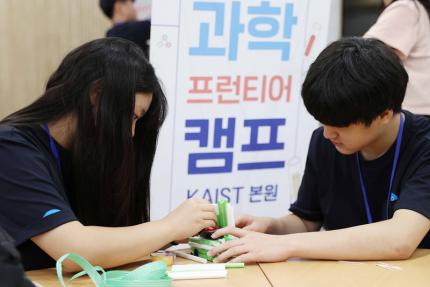 event KAIST Holds '2025 KAIST Science Frontier Camp' for Multicultural Youth
event KAIST Holds '2025 KAIST Science Frontier Camp' for Multicultural Youth<2025 KAIST Science Frontier Camp Activities> KAIST (President Kwang Hyung Lee) announced on the 18th of July that it hosted the '2025 KAIST Science Frontier Camp' for multicultural youth from the 15th for three days and two nights at the Creative Learning Building on its main campus in Daejeon. This event was organized in accordance with the 'Multicultural Talent Nurturing Agreement' signed by KAIST and GS Caltex in 2024. It marks the first year of a mid-to-long-term project in which 100 million KRW in development funds will be contributed annually for four years. The Global Institute for Talented Education organized the camp, and approximately 30 middle school students from multicultural families affiliated with the 'Hanmaum Educational Volunteer Group' (Director, Honorary Professor Byung Kyu Choi), a mentoring and volunteer organization for multicultural students, participated. The camp participants enjoyed developing their scientific thinking skills and problem-solving abilities, and broadening their understanding of STEM (Science, Technology, Engineering, and Mathematics) career paths through a variety of science activity programs, including: △'Black Box: Record the Egg's Last Moment!' △'Find the Best Strategy! Heuristic Algorithm Challenge' △'Future Society and AI, Finding Career Directions' △'Distance Dominates the World!' and △'Career Talk Concert.' During the opening ceremony, Director Byung Kyu Choi delivered a congratulatory speech. Additionally, Yong Hyun Kim, Dean of Admissions at KAIST, gave a special lecture titled 'La La Land KAIST – A Story of Chasing the Dream of a Young Scientist,' sharing honest stories about careers and dreams as a scientist. Gi Jung Yoo, a freshman from the Division of Undeclared Majors who participated in the camp as a student mentor, shared that he had a very meaningful time mentoring the participating students, who are future STEM hopefuls, sharing vivid experiences as well as insights on metric functions. He added his hope that more students would be given such opportunities. < Students Actively Taking Part in the Camp Activities> Si Jong Kwak, Director of the Global Institute for Talented Education, stated, "We hope this will be a practical way to help students foster their interest in science, learn the joy of discussion and communication, and design their future." KAIST President Kwang Hyung Lee remarked, "This camp was a valuable opportunity for students from diverse cultural backgrounds to gain confidence through science and envision their future." He added, "KAIST will continue to dedicate efforts to nurturing multicultural talent and contribute to creating a sustainable society." Since 2024, KAIST has introduced and selected multicultural students through its Equal Opportunity Admission track. Utilizing the development funds from GS Caltex, KAIST also established the 'GS Caltex Multicultural Excellence Scholarship Program.' Through this scholarship program, undergraduate students from multicultural families receive living expenses each semester, allowing them to focus more stably on their studies. As the number of applicants for the Equal Opportunity Admission track is increasing every year, more multicultural students are expected to benefit from scholarships in the future. Additionally, in May, both organizations invited Ms. Si Si Wu Fong, a foreign employee at GS Caltex, to give a special lecture titled 'Working Life for Foreigners in Korea' to support foreign students' career exploration. Foreign students who attended the lecture reported positive feedback, stating that they gained practical career information and were motivated to pursue employment in STEM fields in Korea. KAIST plans to continue strengthening its efforts to nurture multicultural talent, increase understanding of the upcoming multicultural society, and help spread social values. <At the 2025 KAIST Science Frontier Camp>
-
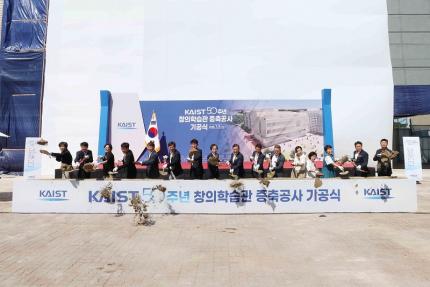 event KAIST Kicks Off the Expansion of its Creative Learning Building, a 50th Anniversary Donation Landmark
event KAIST Kicks Off the Expansion of its Creative Learning Building, a 50th Anniversary Donation LandmarkKAIST announced on July 10th that it held a groundbreaking ceremony on July 9th for the expansion of its Creative Learning Building. This project, which celebrates the university's 50th anniversary, will become a significant donation-funded landmark and marks the official start of its construction. <(From left) President Kwang Hyung Lee, Former President Sung-Chul Shin> The groundbreaking ceremony was attended by key donors who graced the occasion, including KAIST President Kwang Hyung Lee, former President Sung-Chul Shin, Alumni Association President Yoon-Tae Lee, as well as parents and faculty member. The Creative Learning Building serves as a primary space where KAIST undergraduate and graduate students attend lectures, functioning as a central hub for a variety of classes and talks. It also houses student support departments, including the Student Affairs Office, establishing itself as a student-centric complex that integrates educational, counseling, and welfare functions. This expansion is more than just an increase in educational facilities; it's being developed as a "donation landmark" embodying KAIST's identity and future vision. Designed with a focus on creative convergence education, this project aims to create a new educational hub that organically combines education, exchange, and welfare functions The campaign included over 230 participants, including KAIST alumni Byung-gyu Chang, Chairman of Krafton, former Alumni Association President Ki-chul Cha, Dr. Kun-mo Chung (former Minister of Science and Technology), as well as faculty members, parents, and current students. They collectively raised 6.5 billion KRW in donations. The total cost for this expansion project is 9 billion KRW, encompassing a gross floor area of 3,222.92㎡ across five above-ground floors, with completion targeted for September 2026.
-
 Chosun Biz KAIST and KRISS develop Li-Fi device 100 times faster than Wi-Fi with encryption
Chosun Biz KAIST and KRISS develop Li-Fi device 100 times faster than Wi-Fi with encryptionhttps://biz.chosun.com/en/en-science/2025/06/24/IAIJE7KJKJF4JHF4N2N4CTCIZU/
2025.07.18 -
 National Research Council of Science and Technology With Only a Small Amount of Additives, It Opens an Ion Highway in the Battery Electrolyte
National Research Council of Science and Technology With Only a Small Amount of Additives, It Opens an Ion Highway in the Battery Electrolytehttps://www.newswise.com/articles/with-only-a-small-amount-of-additives-it-opens-an-ion-highway-in-the-battery-electrolyte
2025.07.18 -
 Technology Networks Alcohol Triggers Liver Inflammation Through New Cell Pathway
Technology Networks Alcohol Triggers Liver Inflammation Through New Cell Pathwayhttps://www.technologynetworks.com/cell-science/news/alcohol-triggers-liver-inflammation-through-new-cell-pathway-402439
2025.07.18 -
 Tech Xplore Robot hand 'feels' pain and ignores harmless touch with new sensory system
Tech Xplore Robot hand 'feels' pain and ignores harmless touch with new sensory systemhttps://techxplore.com/news/2025-07-robot-pain-harmless-sensory.html#google_vignette
2025.07.18 -
 Technology Networks How Brain Stem Cells Enter and Exit a Quiescent State
Technology Networks How Brain Stem Cells Enter and Exit a Quiescent Statehttps://www.technologynetworks.com/cell-science/news/how-brain-stem-cells-enter-and-exit-a-quiescent-state-402449
2025.07.18